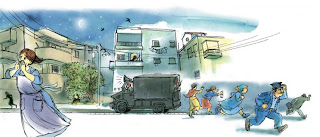G: Of course the greatest difference between your books and ours is that yours read from right to left which feels very strange to us.
N: Yes, we read and write from right to left, and in a way, I guess we also “illustrate from right to left” - this is something that is done in an unconscious way, just as you probably “illustrate from left to right” - when a character leaves his home and go on a journey, he would walk from right to left, in a Hebrew book (and probably the other way, in an English book). So when translating a book into English, we would sometimes flip the illustrations as well.
I have another question: Israel is a much smaller country than the UK, what impact does this have on your children’s publishing industry?
N: Not only is Israel
Yet, Israel
Israelis like buying their own books and "own" them, and until recently borrowing books in libraries was not very common. Also, in Israel
Under Grandpa's Umbrella written by Raphaella Serfaty Acrylic on paper
G: So there's a lot book purchasing going on. Does this mean, in Israel , it is easier for mid-list authors and illustrators to earn a living than in the UK
N: Although there's a need for new children's books all the time, authors and illustrators are not well compensated. The agreements signed with publishers are very strict - some times you get royalties only after the first edition (about 2000 copies) is sold (this is mostly relevant to authors, as illustrators are normally paid a one-time fee and not royalties). New authors and illustrators might be asked to pay some of the printing and marketing fees.
This is why I, along with my husband, Lavish, and our two daughters - Shulamit and Raphaella decided to establish our own publish company. Jolly Giraffe.
Where Are the Clouds Going to? written by Lea Tzur Papercuts
G: I’d love to hear more about your publishing company and the physical books you publish - I'll devote another post to your apps.
N: Our publishing company found the niche of preschool visits where I run my visits and also sells books. Preschools have budget for birthday gifts and end of the year events (like you have for Christmas here), and we sometimes manage to market our books as an idea for these occasions. In these cases a preschool might buy 30 copies of a book.
We publish our own books, which we write, illustrate and design, as well as other authors’ books.
I would say half of the manuscripts we published are children’s books and half are more like Memoirs. Israel is a relatively young country and people feel they need to tell their personal stories - whether it’s to share childhood memories from their mother land, to recount how they survived the Holocaust, to tell how they immigrated to Israel
G: You are
illustrating a children's book about the Holocaust. Can you say a little about it?
N: It’s a story about a little girl who survived
the war together with her mother. The author of the story gave me a photo album
with pictures of her family. I thought it would be nice to integrate the photos
in the illustrations, making a collage of my illustrations and the original
photos. For the illustrations themselves I used watercolors and then added some
airbrush effects on photoshop.
G: These pictures
are still at the rough stage, but they are so full of feeling, I know this is
going to be a moving and powerful book, Nurit. Thank you so much for allowing
us an early glimpse of it and also for sharing this perspective on Israeli picture books.


























